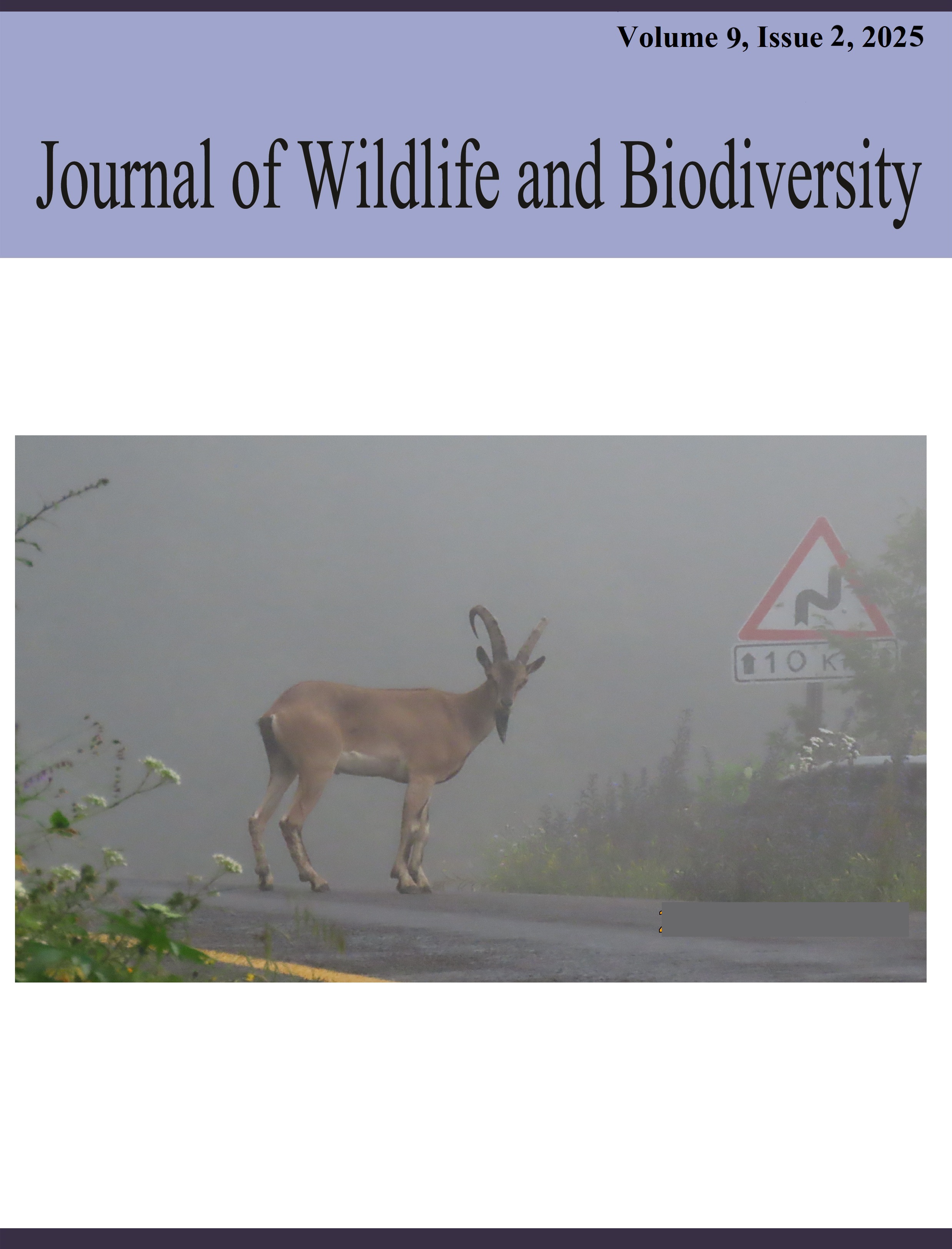Understanding the impact of climate change on honey bees' distribution in Pakistan: A predictive approach using historical data
DOI:
https://doi.org/10.5281/zenodo.15528204Keywords:
Apis florea, Apis cerana, Apis mellifera, Apis dorsata, PakistanAbstract
This study investigated the potential future distribution of three honey bee species, viz., Apis florea, Apis cerana, and Apis dorsata in Pakistan. The data was collected based on sighting records through field surveys, literature review, and from the Global Biodiversity Information Facility (GBIF). Maxent software was used to incorporate GPS coordinates and bioclimatic data to predict the future distribution of the honey bee species in Pakistan. A model habitat suitability based on 19 different bioclimatic variables from WorldClim was used to compare current and projected (2050) climatic scenarios. The results indicated a general warming trend for all three species with expected average annual increases in temperature and precipitation. Apis florea is scheduled to face a 2.5°C rise in the annual mean temperature, while Apis cerana and Apis dorsata will face increases of 2.4°C and 2.3°C, respectively. An increase in precipitation ranging from 50 to 60 mm annually is expected. This expected increase in temperature and precipitation could enhance foraging behaviour during a few months of the year, and the heat stress in warmer months poses a significant challenge to the survival of the honey bee species. Moreover, variations in seasonal patterns, including mild winter and increased humidity, could disrupt honey bees' activity, the colony dynamics, and plants' physiology. These factors require making resilient habitats for honey bees, and this can be done by planting resilient plants and maintaining habitats that provide suitable shelter from extreme heat. It is recommended that species distribution models should also consider other variables, including land use changes, pesticide use, and disease prevalence, to provide a more comprehensive understanding of how honey bee species may respond to climate change in the future.
References
Akram, W., Sajjad, A., Ali, M., Khurram, H., & Rafique, M. K. (2024). Communities of Arid Bees as Affected by Weather Factors and Foraging Resources in Southern Punjab, Pakistan. Pakistan Journal of Zoology, https://dx.doi.org/10.17582/journal.pjz/20240218031246
Cook, D., Tarlinton, B., McGree, J. M., Blackler, A., & Hauxwell, C. (2022). Temperature sensing and honey bee colony strength. Journal of Economic Entomology, 115(3), 715-723.
Diaz Calafat, J. (2024). Boreal pollinators in a changing climate. Acta Universitatis Agriculturae Sueciae. https://doi.org/10.54612/a.18rsgbp5pk
Fleming, J. M., Carter, A. W., & Sheldon, K. S. (2021). Dung beetles show metabolic plasticity as pupae and smaller adult body size in response to increased temperature mean and variance. Journal of Insect Physiology, 131, 104215.
Gebremedhn, H., Gebrewahid, Y., Haile, G. G., Hadgu, G., Atsbha, T., Hailu, T. G., & Bezabih, G. (2024). Projecting the impact of climate change on honey bee plant habitat distribution in Northern Ethiopia. Scientific Reports, 14(1), 15866.
Ghassemi-Khademi, T., Khosravi, R., Sadeghi, S., & Ebrahimi, M. (2022). Historical, current, and future climate niche of the red dwarf honey bee across its native range. Journal of Apicultural Research, 61(2), 271-283.
Giannoni-Guzmán, M. A., Rivera-Rodriguez, E. J., Aleman-Rios, J., Melendez Moreno, A. M., Pérez Ramos, M., Pérez-Claudio, E., & Agosto-Rivera, J. L. (2021). The role of colony temperature in the entrainment of circadian rhythms of honey bee foragers. Annals of the Entomological Society of America, 114(5), 596-605.
Harmon-Threatt, A. (2020). Influence of nesting characteristics on health of wild bee communities. Annual Review of Entomology, 65(1), 39-56.
Harrison, P. A. (2021). Climate change and the suitability of local and non‐local species for ecosystem restoration. Ecological Management & Restoration, 22, 75-91.
Harvey, J. A., Tougeron, K., Gols, R., Heinen, R., Abarca, M., Abram, P. K., & Chown, S. L. (2023). Scientists' warning on climate change and insects. Ecological monographs, 93(1), e1553.
Ji, Y. (2021). The geographical origin, refugia, and diversification of honey bees (Apis spp.) based on biogeography and niche modeling. Apidologie, 52(2), 367-377.
Kevan, P. G., Rasmont, P., & Martinet, B. (2024). Thermodynamics, thermal performance and climate change: temperature regimes for bumblebee (Bombus spp.) colonies as examples of superorganisms. Frontiers in Bee Science, 2, 1351616.
Khan, W., Khan, N., & Naz, S. (2017). Beekeeping in federally administered tribal areas of Pakistan: Opportunities and constraints. Sarhad Journal of Agriculture, 33(3), 459-465.
Kumar, A., Rajwar, N., & Tonk, T. (2024). Climate Change Effects on Plant-Pollinator Interactions, Reproductive Biology and Ecosystem Services. In Forests and Climate Change: Biological Perspectives on Impact, Adaptation, and Mitigation Strategies (pp. 97-117). Singapore: Springer Nature Singapore.
Makori, D. M., Fombong, A. T., Abdel-Rahman, E. M., Nkoba, K., Ongus, J., Irungu, J., & Landmann, T. (2017). Predicting spatial distribution of key honeybee pests in Kenya using remotely sensed and bioclimatic variables: Key honeybee pests distribution models. ISPRS International Journal of Geo-Information, 6(3), 66. https://doi.org/10.3390/ijgi6030066
Mishra, M., Bhunia, P., Sen, R., Bhunia, R., Gulia, J., Mondal, T., & Kaushal, L. (2023). The Impact of Weather Change on Honey Bee Populations and Disease. Journal of Advanced Zoology, 44. 180. https://doi.org/10.17762/jaz.v44is7.2755
Mitchell, D. M. (2022). Honey bee (Apis mellifera) size determines colony heat transfer when brood covering or distributed. International Journal of Biometeorology, 66(8), 1653-1663.
Orr, M. C., Hughes, A. C., Chesters, D., Pickering, J., Zhu, C. D., & Ascher, J. S. (2021). Global patterns and drivers of bee distribution. Current Biology, 31(3), 451-458.
Ostroverkhova, N. V., Konusova, O. L., Kucher, A. N., Kireeva, T. N., & Rosseykina, S. A. (2020). Prevalence of the Microsporidian nosema spp. in honey bee populations (Apis mellifera) in some ecological regions of North Asia. Veterinary Sciences, 7(3), 111.
Saeed, S. (2022). Bee Diversity of Pakistan. In Biodiversity, Conservation and Sustainability in Asia: Volume 2: Prospects and Challenges in South and Middle Asia (pp. 487-519). Cham: Springer International Publishing.
Villagomez, G. N., Nürnberger, F., Requier, F., Schiele, S., & Steffan‐Dewenter, I. (2021). Effects of temperature and photoperiod on the seasonal timing of Western honey bee colonies and an early spring flowering plant. Ecology and Evolution, 11(12), 7834-7849.
Downloads
Published
How to Cite
Issue
Section
License
Copyright (c) 2025 Journal of Wildlife and Biodiversity

This work is licensed under a Creative Commons Attribution 4.0 International License.


